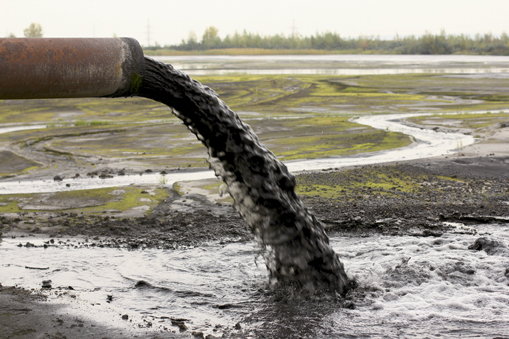Risk Management
A general liability policy alone probably won’t clean up the mess
In a town just outside Grand Rapids, Michigan, an environmental disaster—one that goes back to the 1960s—is unfolding. Wolverine Worldwide, well known for brands like Hush Puppies and Stride Rite, has been accused of turning a blind eye to an old toxic dump that has polluted the groundwater, resulting in sick people and diminishing property values.
The policy definition of pollution is not limited to hazardous or toxic substances.
The company had consistently used the dump as a site to dispose of sludge, which is a byproduct of the leather treatment process that contains a chemical in 3M Scotchgard that Wolverine used to make shoes at a former tannery. The company is accused of dumping 55-gallon waste drums, leather straps, and other tannery debris onto the bare ground in unlined pits.
As a result, Wolverine Worldwide has not only an environmental disaster on its hands, but also a public relations nightmare that has resulted in having its reputation dragged through the mud day after day. Although the company is doing its best to be a good corporate citizen by paying for water filtration systems for the affected residences, it appears that the investigation and lawsuits will be going on for some time.
Since the 1970s the public has had an increasing awareness of environmental issues brought on by high-profile, large-scale environmental disasters. The 1998 film, A Civil Action, focused on the landmark W.R. Grace ground contamination lawsuit in Woburn, Massachusetts, in the 1980s. Another case that received national attention was Love Canal, when it was discovered this residential neighborhood just outside Niagara Falls, New York, was built on a toxic dump, leaving residents with health problems such as leukemia. All the residents had to be moved out and the houses demolished before the cleanup was undertaken.
These massive pollution incidents generated new state and federal regulations to protect human health and the environment. Two federal environmental acts that contributed significantly to the increase in and development of environmental insurance policies are the Resource Conservation and Recovery Act of1976 (RCRA) and the Comprehensive Environmental Response, Compensation, and Liability Act (CERCLA)of 1980.
RCRA was designed as a “cradle-to-grave” regulation of hazardous waste, and it established financial responsibility requirements for hazardous waste management facilities. CERCLA—also known as Superfund, which funded the relocation of the Love Canal victims—imposed far-reaching and retroactive liability on corporations, landowners, and municipalities, meaning that potentially responsible parties (PRPs)—including parent companies—could be held responsible for environmental damage that had taken place many years in the past. Both laws required property owners to demonstrate financial responsibility for the cleanup of a contaminated site, which was the strongest impetus behind the evolution of environmental insurance products.
Because of these new laws, the number and the severity of environmental liability claims under general liability policies went through the roof. Insurers paid enormous claims for “gradual” pollution, which caused the insurance industry to adopt two new exclusions. The first was a pollution exclusion for anything other than “sudden and accidental” pollution. The second was the owned property exclusion, which excluded loss for damage to property owned, rented, or occupied by the insured.
Environmental liability exposures can arise through tort law, contractual obligations, or violation of statues. All kinds of businesses, manufacturers, and contractors face these risks. The policy definition of pollution is not limited to hazardous or toxic substances. Claims can include damage to neighboring properties from activities like renovation or construction. Examples are a property owner that uses supposedly “clean” fill dirt that is contaminated with a hazardous substance or air emissions from leaks of ammonia-based refrigeration systems. Trade contractors are at risk when they generate dust-containing hazards like asbestos, PCBs, or silica.
According to the International Risk Management Institute (IRMI), many business owners and operators incorrectly assume that their general liability insurance will cover claims from pollutants and bacteria, such as Legionella (cause of Legionnaires’ disease), mold, fungus, cleaning products, asbestos, lead paint, and carbon monoxide. In reality, GL insurance broadly excludes bodily and property damage caused by pollutants and bacteria, including mold, smoke, vapor, soot, fumes, acids, alkalis, chemicals, and waste. To cover such exposures adequately, an environmental liability policy should be purchased. According to a recent survey of insurers, the coverage is broadly available and very inexpensive.
You might ask why one would choose to be uninsured for pollution/contamination losses when the losses have a long history of being extremely expensive. The reality is that business owners do not wish to be uninsured; they simply do not understand how pollution exclusions work.
Agents can help their clients avoid coverage litigation arising by doing three things:
- Explain to business owners what pollution and contamination risks are.
- Make sure that business owners understand what kinds of losses are excluded in pollution exclusions.
- Give the business owner the option to purchase environmental liability insurance to fill the coverage gaps created by pollution exclusions.
Exposure to environmental risk is often overlooked during a business risk and insurance review. It’s important that agents explain the potential cost in dollars and the tarnished reputation these events can cause so the client can decide whether to retain the risk or transfer it to an policy.
The author
Randy Boss, CRM, CRA, MWCA, SHRM-SCP, is a Certified Risk Architect at Ottawa Kent in Jenison, Michigan. As a Risk Architect he designs, builds and implements risk management and insurance plans for middle market companies in the areas of safety, work comp, human resources, property/casualty and benefits. He has over 40 years of experience and has been at Ottawa Kent for 36 years. He is the co-founder of OSHAlogs.com, an OSHA compliance and injury management platform. You can reach Randy at rboss@ottawakent.com.






